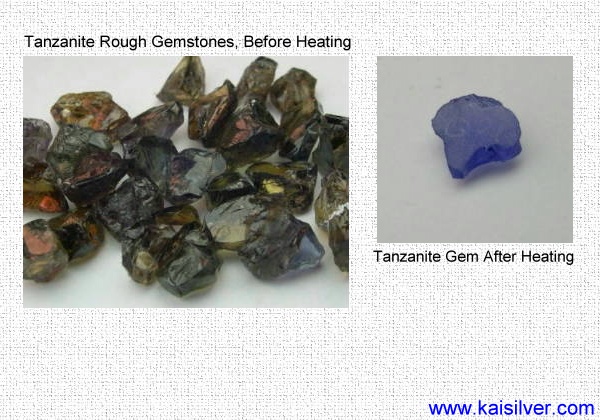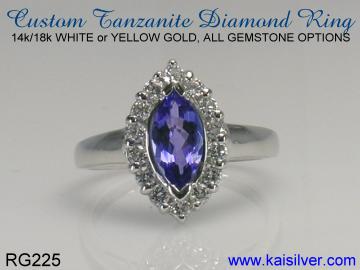Unveiling The Hidden Beauty Of Tanzanite
Tanzanite has been a new entry in gem markets. Compared to gems like ruby, sapphire and emerald which were well known many centuries ago, tanzanite first came to light only around 1967. Interesting stories surround the first find of this amazing gemstone, some claim that it was an Indian tailor in Tanzania who first came across the stone. Others insist that it was a group of local herdsmen who stumbled upon some gorgeous blue crystals on their daily rounds. The 'gorgeous blue stone' part of the story is interesting because, less than 5% of tanzanite is naturally violet or violet-blue when brought out of the earth. It takes human intervention to unveil the stunning color of tanzanite, read on as this is very interesting.

Rough tanzanite in its natural form is generally a yellow-brown-green murky colored stone. To the untrained eye, this would not appear to have much value and seems quite ordinary. Heating the stone to around 500 degrees centigrade, brings out the blue and violet hues in the stone. It obviously is not as easy as it sounds, there are many critical factors to be considered and observed when performing the heat treatment on tanzanite. There is always a risk of the stone cracking or breaking as it is heated in the oven. The probability of such destruction increases when the original stone has cracks or fissures present in it. Since tanzanite is an expensive gem, manufacturers make great efforts to reduce the possibility of breakage during the heating process. It is therefore common for tanzanite rough to be given a basic shape and form and take off portions that show cracks or fissures before, heating them. The stones put into the oven need to be observed periodically, they are taken out when the desired color is achieved.
Once taken out of the oven, the tanzanite gems are given their final shape before being faceted and polished - this step poses its own set of challenges. Tanzanite shows different colors when seen from different directions, the most desirable of these colors are blue and violet. Gem cutters with tremendous experience and skills are required, to observe each piece of tanzanite and orient it in the right direction before the first cut is made. And some where in this complicated equation, the vital requirement would be to 'waste' as little rough stone as possible doing the cutting and shaping process. The optimum shape, size, depth and cut are all mentally calculated for every single piece of tanzanite before, actually beginning to cut the stone.
Now let's get back to the stage where the initial find for tanzanite was made when, a passerby noticed some amazing blue gems on the ground. Experts believe that those few pieces of tanzanite that are found with a blue color were in fact heated by natural conditions. Tectonic activity, earthquakes or stark change in pressure could have generated heat which then, reacted with the rough tanzanite and changed its color. A person with knowledge about gems would refer to such tanzanite as being 'untreated'. It is this untreated tanzanite that can carry a premium price. Since most tanzanite lovers would expect to have eye clean gems, it is unlikely that untreated tanzanite with many inclusions and fissures would command a high price.
And should you pay a premium price for a tanzanite gem just because, the seller mentioned that it was untreated - our answer would be better given in the form of an explanation. Firstly if you really appreciate wearing or owning an untreated tanzanite gem, make sure that it is not very compromised in terms of uniformity of color and clarity. The next thing is to ensure that the gem is accompanied by a certificate from a reputed laboratory, the fact that the tanzanite is not treated should be clearly mentioned on the document. Each country has its own set of gem testing labs that can be classified as 'reputed' so, get to know what is best for your location. If you happen to source your tanzanite from Thailand the recommended laboratories would be AIGS, GIT and GIA. Unless the gemstone is very expensive, sellers normally expect the buyer to pay the cost of certification, you can expect this to be in the range of 60 U.S$ to 100 U.S$ per piece.
 Kaisilver: We are the leaders in online custom made jewelry, we craft all types of jewelry in gold or 925 silver with design and gems of your choice. Over 7,000 quality conscious gem and jewelry lovers across the globe rely on us for all their requirements. Most of our gems are sourced directly from the mines, this allows us to pick the best piece for each price range. We also have preferential access to more than 200 million carats of cut and polished gems. Some of Thailand's best craftsmen and artisans work on all Kai Silver jewelry orders irrespective, of the metal selection. By providing the same quality of workmanship and designs for both gold and 925 silver jewelry, we prove our commitment to quality irrespective of the price point of the jewel.
Kaisilver: We are the leaders in online custom made jewelry, we craft all types of jewelry in gold or 925 silver with design and gems of your choice. Over 7,000 quality conscious gem and jewelry lovers across the globe rely on us for all their requirements. Most of our gems are sourced directly from the mines, this allows us to pick the best piece for each price range. We also have preferential access to more than 200 million carats of cut and polished gems. Some of Thailand's best craftsmen and artisans work on all Kai Silver jewelry orders irrespective, of the metal selection. By providing the same quality of workmanship and designs for both gold and 925 silver jewelry, we prove our commitment to quality irrespective of the price point of the jewel.
You can contact our support experts at sales@kaisilver.com with any queries that you might have. If you are interested in tanzanite rings, review our Tanzanite Ring Collection and get an idea of what we can do for you. While you can pick the design for your tanzanite ring from our website, we also welcome your own design ideas and images to be custom made.
